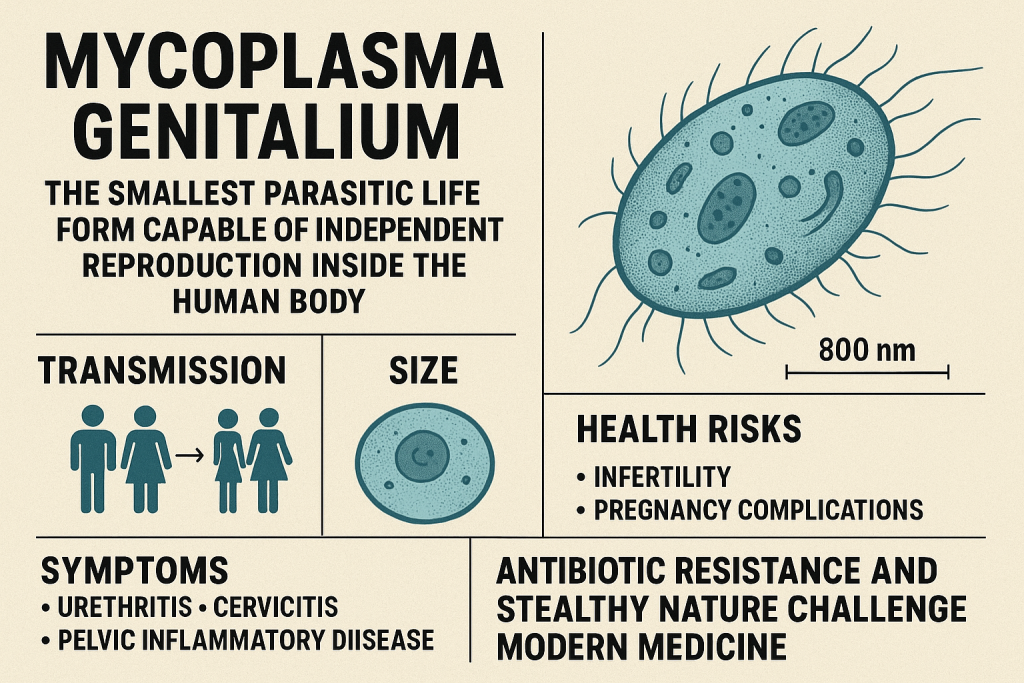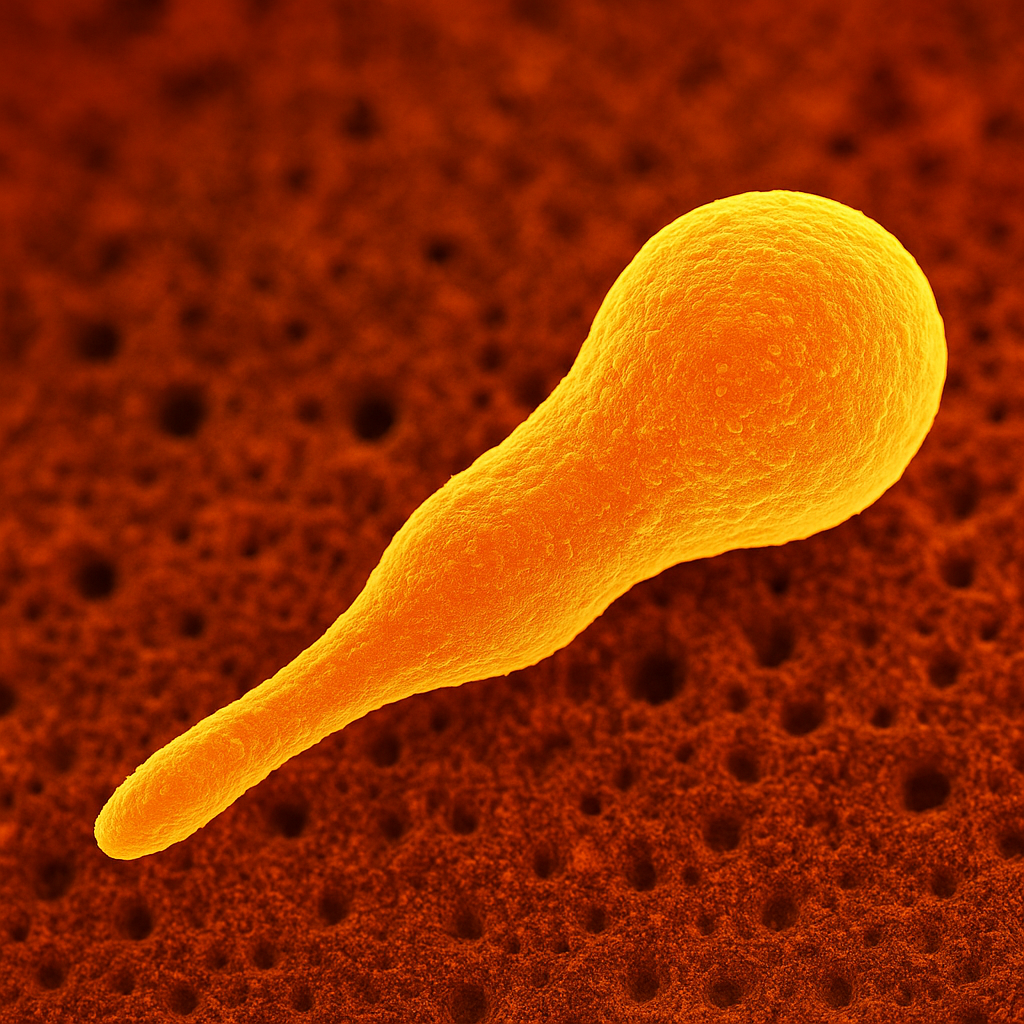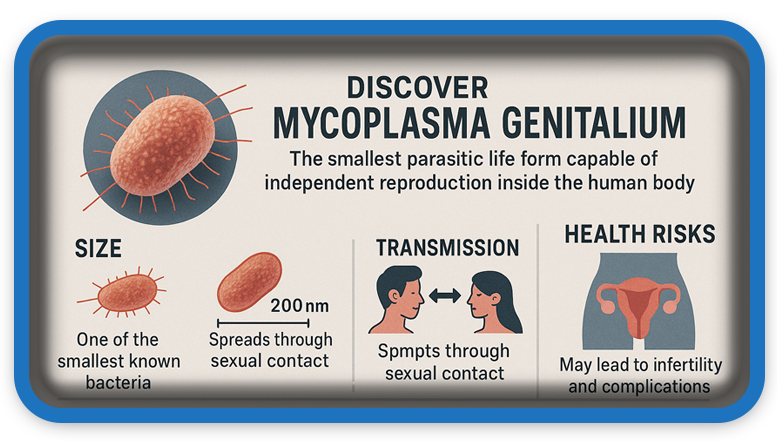⏲️ Estimated reading time: 4 min
Discover Mycoplasma genitalium, the smallest parasitic life form capable of independent reproduction inside the human body. Learn about its size, transmission, symptoms, health risks, and why it challenges modern medicine due to its antibiotic resistance and stealthy nature.
The Smallest Parasitic Life Form in the Human Body. When we think about parasites, we often imagine worms or visible organisms. However, the human body can host microscopic parasites so small that even powerful microscopes struggle to capture their details. Among them, Mycoplasma genitalium holds a remarkable record it is the smallest known parasitic life form capable of reproducing independently inside our bodies.
What Is Mycoplasma genitalium?
Mycoplasma genitalium (often abbreviated as M. genitalium or Mgen) is a bacterium discovered in the early 1980s. Measuring only 200–300 nanometers in diameter, it is so tiny that around 500 of them could line up across the width of a human hair.
It lacks a cell wall a feature that gives it unique properties:
- Greater flexibility in shape
- Resistance to antibiotics that target cell walls, such as penicillin
- Ability to cling tightly to host cells

Why Is It Considered a Parasite?
Although technically a bacterium, M. genitalium behaves like a parasite because:
- It relies on human cells to survive, drawing nutrients directly from them.
- It attaches itself to mucosal surfaces in the urinary and genital tracts.
- It causes damage to host tissues while reproducing.
Where Does It Live in the Human Body?
The organism primarily infects:
- The urethra (in people of all genders)
- The cervix (in women)
- The upper genital tract (in more severe infections)
In rare cases, it can also be found in the rectum and throat, especially in people with multiple sexual partners.
How Is It Transmitted?
The main transmission route is sexual contact, including:
- Vaginal intercourse
- Anal intercourse
- Oral sex (less common)
Because many people show no symptoms, it can spread silently within a population.
Symptoms of Mycoplasma genitalium Infection
In men:
- Burning sensation when urinating
- Urethral discharge
- Irritation or inflammation of the urethra
In women:
- Abnormal vaginal discharge
- Pelvic pain
- Pain during intercourse
- Irregular bleeding between periods

Health Risks and Complications
If left untreated, M. genitalium can cause:
- Urethritis (inflammation of the urethra)
- Cervicitis (inflammation of the cervix)
- Pelvic inflammatory disease (PID)
- Infertility due to damage in reproductive organs
- Increased risk of HIV transmission due to tissue inflammation
The Antibiotic Resistance Problem
One of the greatest challenges with M. genitalium is its growing resistance to antibiotics.
- Macrolides (like azithromycin) once the main treatment are becoming less effective due to resistance mutations.
- Fluoroquinolones (like moxifloxacin) are often the second-line treatment, but resistance is increasing here as well.
This means infections can persist despite treatment, making M. genitalium a serious concern for public health.
How Is It Diagnosed?
Because it is extremely small and slow-growing, M. genitalium is not detected in standard bacterial cultures.
Diagnosis usually involves:
- NAAT (Nucleic Acid Amplification Test) detects the organism’s DNA
- Testing is often done only when symptoms remain after standard STD treatments
How to Prevent Infection
While there is no vaccine, you can reduce the risk by:
- Using condoms consistently
- Limiting the number of sexual partners
- Getting tested for STDs regularly, especially after unprotected sex
- Informing partners if you test positive
Why M. genitalium Is Important in Science
This tiny bacterium is not just a medical concern it is also a scientific curiosity. It has one of the smallest genomes of any free-living organism, containing only around 580,000 base pairs. This makes it a model organism for genetic research, synthetic biology, and understanding the minimal requirements for life.
Final Thoughts
Mycoplasma genitalium proves that size is not always an indicator of danger. Despite its microscopic dimensions, it can cause serious health issues, resist multiple antibiotics, and remain undetected for years. As science advances, better diagnostics and treatments are needed to keep this tiny but troublesome parasite under control.
🔔 For more tutorials like this, consider subscribing to our blog.
📩 Do you have questions or suggestions? Leave a comment or contact us!
🏷️ Tags: Mycoplasma genitalium, smallest parasite, human parasites, STD bacteria, antibiotic resistance, urinary tract infection, pelvic inflammatory disease, sexual health, microscopic organisms, medical research
📢 Hashtags: #MycoplasmaGenitalium, #SmallestParasite, #HumanParasites, #STD, #AntibioticResistance, #SexualHealth, #MicroscopicLife, #MedicalScience, #InfectiousDiseases, #HealthAwareness
Only logged-in users can submit reports.
Discover more from HelpZone
Subscribe to get the latest posts sent to your email.

